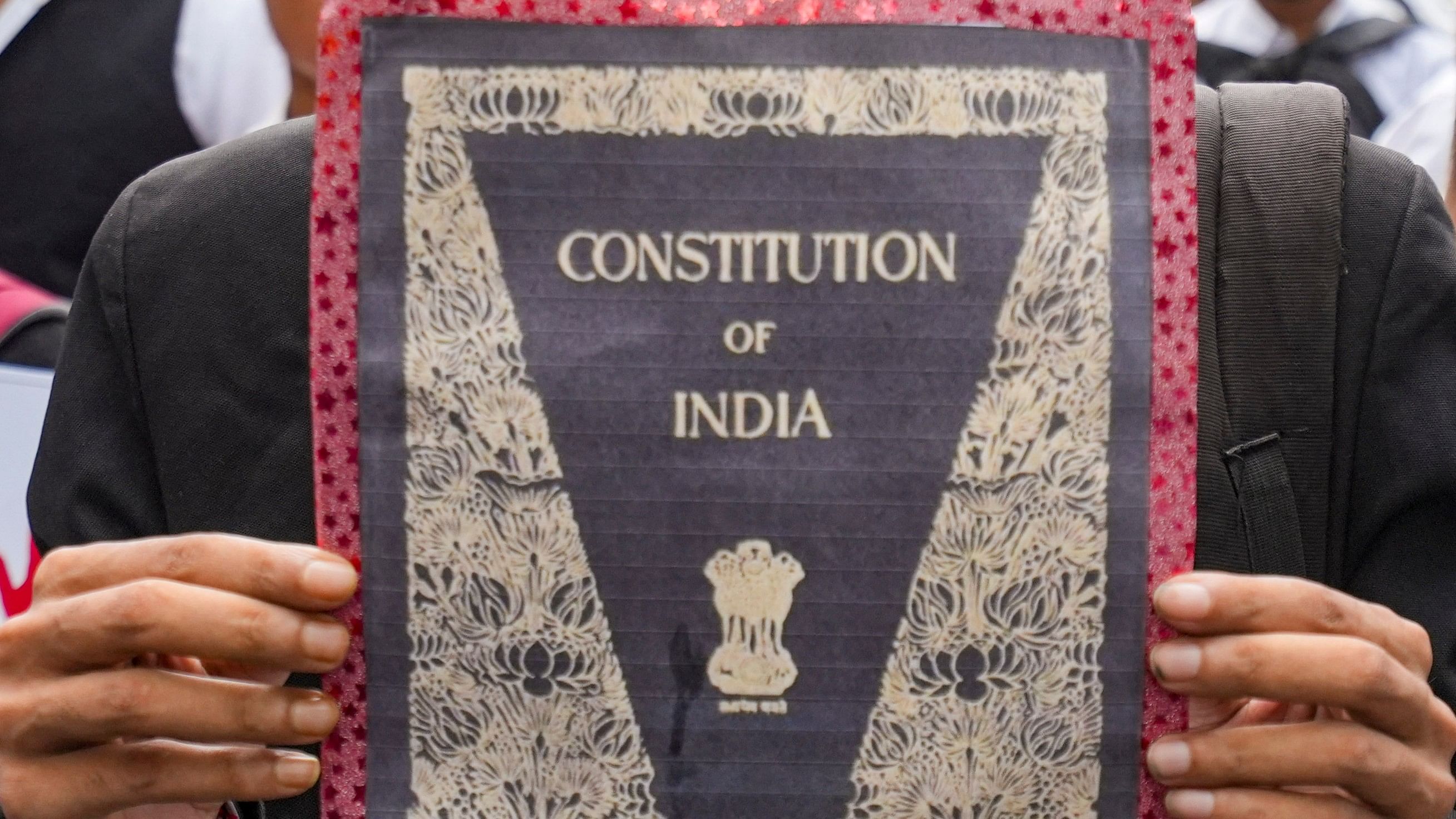
Representative image showing a person holding the Constitution of India
Credit: PTI Photo
Across history constitutions have been written in the wake of terrible social and political upheavals. The objective of constitution-making is to contain State power, and re-institutionalise order in society.
In today’s world, Right-wing authoritarian rulers ignore constraints on State power, and intensify restrictions on rights. The Indian experience bears witness.
If we want to retrieve the normative moorings of our Constitution, we have to go beyond legal constitutionalism to recreate a political community dedicated to the Constitution.
We will do well to recollect that our Constitution was the product of mass struggle against colonialism. During the freedom struggle, Indians asserted that they would write their own constitution. This was in contrast to many former colonies where the departing colonial power handed over a constitution to aspirant political elites.
Universal adult franchise, a Bill of Rights, minority rights, democracy, and a welfare state had been conceptualised by the Indian National Congress over the years. But no one expected that the Constituent Assembly would meet in the shadow cast by the Partition.
On December 11, 1946, Rajendra Prasad, the President of the Assembly said, “the Constituent Assembly is meeting at a most critical time. We all know that other constituent assemblies, whenever and wherever they met, were confronted with similar difficulties. They had also to contend with internal differences which were placed before them with great vehemence… Many of these constituent assemblies were held amidst strife and bloodshed; even their proceedings were conducted amidst quarrels and fights. Their members joined together and with courage, kindness, generosity, tolerance and regard for one another’s feelings framed constitutions which were then readily accepted by the people of the countries for which they were framed.”
This was the specific mandate of the Constituent Assembly: to create a political community inhabited by citizens who held rights, and who owed obligations to each other.
The defining feature of a democratic political community, united by allegiance to the Constitution is dialogue. A society is not held together by the dry bones of law but by solidarity. Citizens inhabit a community of fate, they owe each other sympathy, solidarity, and respect.
The language of rights is indispensable for democracy because it allots moral stature to individuals. But rights by themselves can easily lead to self-serving action and indifference to others.
The law inhabits a cold hard place. Political communities should be able to reach out to vulnerable sections of society, and to connect with each other on the basis of sympathy and solidarity.
The task of creating a political community based on democratic norms was challenging. Approximately 8 million Hindus and Sikhs moved from what is now Pakistan to India, and 6-7 million Muslims from India migrated to Pakistan between 1947 and 1951 in one of the largest involuntary migrations the world had seen.
Poet Firaq Gorakhpuri famously wrote: “Sar Zamine-e-Hind par aqwame-e-alam ke Firaq/ Kafile baste gaye/ Hindostan banta gaya”. India was created as a plural society, wrote the poet, by successive waves of migration. In 1947, the situation was sadly reversed.
The country witnessed processions of bedraggled, dispossessed people travelling from the East to the West, and from the West to the East of Punjab.
As processions of dispossessed and demoralised individuals, for whom the homeland had become an arid and alien space, crossed each other, people clashed. About 1 million people were killed in bloody massacres, half of this number was in Punjab alone.
It was easy for the Constituent Assembly to conceptualise a Hindu State, but it did not. It conceptualised a secular State where all religions would be held as equal. It conceptualised a democratic State.
Today majoritarianism has taken over, debate is frowned upon, dissent is banned, activists are jailed, and minorities are harassed. Yet, the original intention of the Constitution makers can be retrieved.
Recollect that on December 11, 2019, the Citizenship Amendment Act (CAA) was passed by Parliament. We were quiet. Then a political miracle happened. On December 15, 2019 students belonging to Jamia Milia Islamia in Delhi came out in large numbers to protest against the CAA. Demonstrations that proclaimed solidarity with the Muslim community, that was threatened by the Act, spread across the country.
Indians marched holding the national flag in one hand, and copies of the Constitution in the other. They marched peacefully, and assembled peacefully in public spaces.
They took inspiration from the national flag and portraits of Bhagat Singh, Mahatma Gandhi and B R Ambedkar that formed the background to their meetings. They sang the national anthem and recited revolutionary poetry, particularly Faiz Ahmad Faiz’s poem ‘Hum Bhi Dekhange’.
Young people read out the Preamble of the Constitution that promises, liberty, equality, justice, and fraternity. Through public enactment of the Preamble our young people transformed the Constitution into a public, accessible, and democratic document.
The Constitution, they reiterated, is the anchor of our identity, the protector of our rights, our legacy, and our culture. The occupation of public spaces, sit-downs on public roads, the coinage of innovative slogans realised, proclaimed, and enacted popular sovereignty.
The objective was simple, to reclaim constitutional rights that had been granted to all citizens of India. William Wordsworth had written on the French Revolution thus: “Bliss was it in that dawn to be alive/But to be young was very heaven.”
The message is clear. The Constitution protects us, we have to protect it.